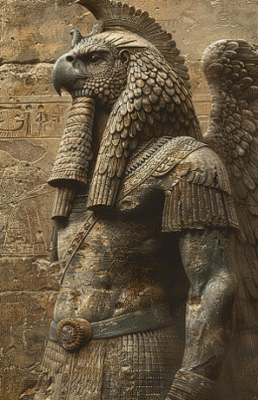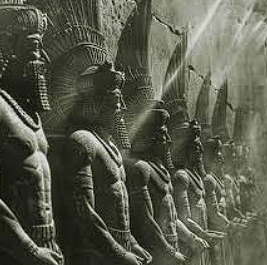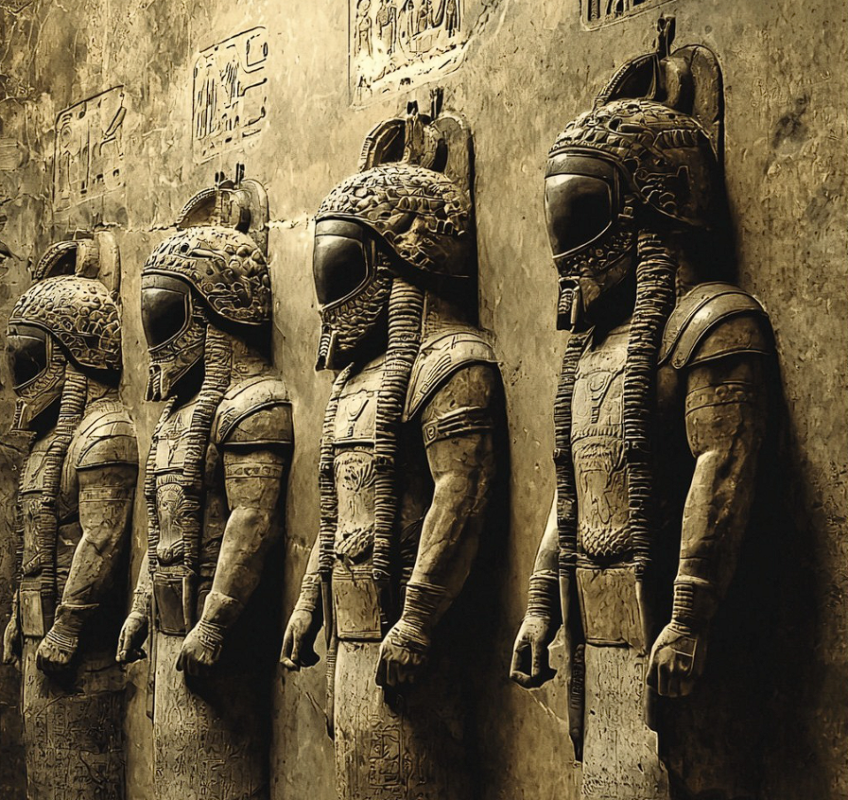Sumerian civilization, one of the oldest known cultures, left behind an astonishing array of artifacts, including intricate carvings and reliefs that depict the Anunnaki—powerful, god-like figures. These depictions have sparked intense debate among scholars and ancient astronaut theorists, particularly due to their seemingly advanced technological elements. Could the Sumerians have encountered beings with knowledge far beyond their own? This article delves into the intriguing artistic representations of the Anunnaki and their potential implications.
The Detailed Portrayal of the Anunnaki in Sumerian Art
1. Distinctive Features and Symbolic Imagery
Sumerian artwork intricately illustrates the Anunnaki with striking, often mysterious characteristics. They are commonly shown with elongated heads, large eyes, and elaborate attire, setting them apart from human figures. These exaggerated features may symbolize their divine status, but some researchers suggest they could indicate an extraterrestrial origin.
Additionally, many reliefs and sculptures emphasize celestial elements, such as stars and planets surrounding the Anunnaki. This repeated motif suggests a strong connection between these deities and the cosmos, leading some to theorize that the Sumerians associated them with visitors from beyond Earth.
2. Advanced Attire and Possible Technological References
One of the most debated aspects of Anunnaki depictions is their elaborate attire. Many carvings show them wearing multi-layered robes with intricate patterns, possibly symbolizing rank or divine power. However, certain elements stand out as particularly unusual—some figures appear to wear helmets that resemble modern-day protective headgear, and others have wrist devices that look strikingly similar to contemporary technological instruments.

These details have fueled theories that Sumerian artists may have been attempting to document actual encounters with advanced beings. While mainstream historians view these depictions as purely symbolic, alternative researchers argue that the art provides clues about lost knowledge or even extraterrestrial contact.
Theories Surrounding the Anunnaki and Their Role in Sumerian Society
1. Mythological Beings or Historical Figures?
The Anunnaki are central to Sumerian mythology, often described as celestial beings who descended from the heavens to shape human civilization. Traditional interpretations view them as metaphorical representations of natural forces or divine rulers. However, the high level of detail in their artistic depictions raises questions—could they have been based on real figures who left a lasting impression on the Sumerians?

Some scholars propose that the Anunnaki were early rulers or priest-kings, whose divine status was later mythologized. Others take a more unconventional approach, suggesting that their presence in historical records might indicate an actual influence from an advanced civilization, possibly one not of this Earth.
2. The Ancient Astronaut Hypothesis
The idea that the Anunnaki were extraterrestrial visitors has gained traction among ancient astronaut theorists. They argue that the detailed artwork, combined with Sumerian texts describing the gods descending from the sky, could be evidence of real encounters with advanced beings. The Sumerians’ advanced knowledge of astronomy and mathematics adds to this speculation—did they receive knowledge from an outside source?
While mainstream archaeology attributes Sumerian achievements to natural intellectual and cultural evolution, proponents of the ancient astronaut theory believe that the Anunnaki may have played a direct role in shaping early human development. Whether as teachers, rulers, or distant observers, their potential influence remains a subject of ongoing debate.
Sumerian Art and Its Connection to Celestial Themes
1. The Fascination with the Cosmos
Sumerian culture displayed a profound interest in astronomy, which is reflected in their art and written records. Many artifacts depict planetary alignments, star constellations, and celestial events, suggesting that the Sumerians had a sophisticated understanding of the cosmos. This raises the question—was their knowledge purely observational, or was it influenced by an external source?
Their creation myths describe the Anunnaki as beings who descended from the heavens, reinforcing the idea that these figures were linked to celestial realms. This strong emphasis on the stars continues to intrigue researchers, as it suggests that Sumerians may have considered themselves part of a larger cosmic network.

2. Symbolism vs. Reality: Decoding the Artistic Message
While some researchers argue that Sumerian depictions of the Anunnaki are purely symbolic, others believe that they contain hidden meanings or even records of real events. The repeated motifs of winged beings, star maps, and strange devices suggest a deeper significance beyond mere mythology.
Could these carvings be early attempts to document actual historical interactions with advanced beings? Or are they simply artistic expressions of religious beliefs? Regardless of the answer, Sumerian art continues to captivate historians, archaeologists, and enthusiasts alike.
Conclusion
The intricate portrayals of the Anunnaki in Sumerian art remain one of the most fascinating mysteries of ancient history. Whether these depictions represent mythological figures, historical rulers, or something far more extraordinary, they offer valuable insight into the mindset and beliefs of the Sumerian civilization.
As research continues, new discoveries may provide further clarity on the true nature of the Anunnaki and their role in shaping early human culture. Until then, their enigmatic presence in Sumerian art continues to inspire curiosity, debate, and wonder about humanity’s ancient past and its possible connections to the stars


CÁC TIN KHÁC
Mary Walton: The Forgotten Inventor Who Helped Clean Up America’s Cities
Tomb of Queen Nefertari in the Valley of the Queens, Egypt
Discover the Hypostyle Hall of the Temple of Hathor at Dendera
Venus de Losange: Unveiling the Mystery of a 20,000-Year-Old Paleolithic Icon